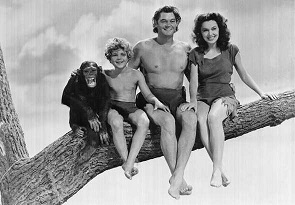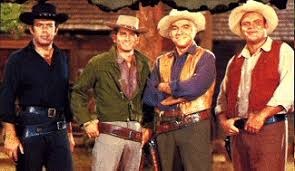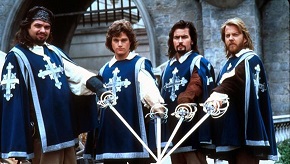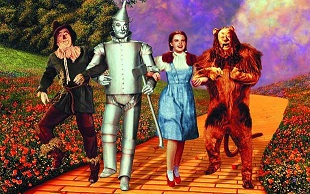page 21
Progressive Thinkers as of 5/8/2020
|
| ||||||||||||||||||||||||||||||||||||||||||||||||||||||||||||||||||||||||||||||||||||||||||||||||||||||||||||||||||||||||||||||||||||||||||||||||||||||
So what in the world is going on here? Is there anything of value to be derived from a study of what I sometimes refer to as the "threes phenomena"? Particularly when we include amongst the examples that the Earth is the 3rd planet from a source of Solar irradiation and that a fundamental constituent of life is DNA and it has a triplet code. Oh I know what some of you may be thinking. That if we look at the fundamental forces of Nature (Strong, Weak, Electro-magnetic, Gravity) we find the quantity listed as being four and that there are four directions (North, South, East, West... despite the use of triangulation in GPS systems), and there are four states of matter (Solids, Liquids, Gases, Plasma)... as well as the Primary, Secondary, Tertiary, Quaternary structure of Proteins. And let me not forget to mention that both DNA and RNA use four recurring amino acid bases: Adenosine, Cytosine, Guanine, Thymine (DNA), Uracil (RNA). I know... you want to trip me up by citing these "four-labeled" examples as a wrench to be thrown into my thinking mechanism of "threes patterns".
The problem is, that use of the label "four" is not scientific enough. It is an artistic perspective, particularly when on closer examination we find a different pattern a bit more subtle which can assist in our research of trying to determine whether or not there is some truth to the idea of a Standard Cognitive Model which can be identified across the spectrum of different subjects. But first, let us take a look at these so-called "four-patterned" ideas so as to highlight what I think is a more telling, if not salient point of investigative value and departs for the standard routinization of thought which appears to be more in line with tradition and superstition than an appreciative grasp inter-connecting different languages and time periods. Simple put, this pattern is a 3-to-1 ratio:
- Standard Model: Four Fundament Universe Forces the strong force, the weak force, the electromagnetic force, and the gravitational force
- Compass Orientations: North, South, East and West
- Four states of matter and one man-made Solids, liquids, Gases and Plasma. The fifth state is the man-made Bose-Einstein condensates.
- Overview of Protein Structural and Functional Folds Primary, Secondary, Tertiary, and Quaternary structure.
- DNA and RNA Nucleotides DNA: Adenosine, Cytosine, Guanine, and Thymine; RNA: Adenosine, Cytosine, Guanine, and Uracil;
Clearly, one might provide other examples of a presumed "four" quantity as an argument against the recurrence of "threes". And while the idea of a "four" is not wrong, it is quite simplistic, whereas differentiating the same examples as 3-to1 ratios permits the ability of distinguishing a broader inclusion of what might otherwise be viewed as disparate considerations for establishing the idea for the existence of a Quantifiable Standard Cognitive formula. For example, all of us (myself included) have seen the above examples (and several others) and taken for granted the language we are using... and can alternatively interpret it to be an expressed mathematical word sentence. In other words, we repeatedly cite three items then separate the three with the word "and" from the following fourth item. The "AND" is like the "COMMA" used in the numerical place value system of expression:
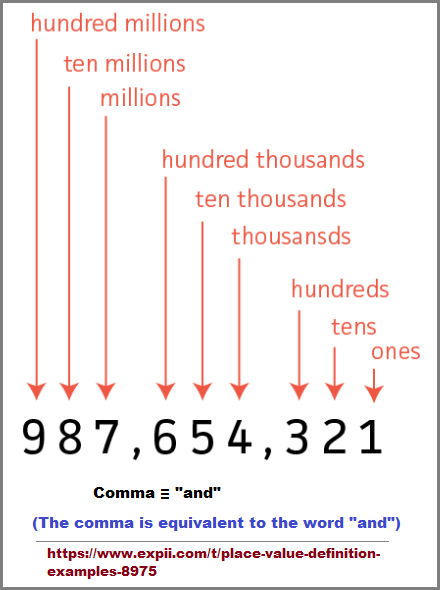
Again, I am speaking in terms of a Standard Cognitive model which has evaded most Researchers interested in finding recurring patterns in the thought-and- language relationship sphere/theater/colosseum/spectrum of activity. While some may argue the use of the "and" is part of grammar, they then overlook not only the recurrence of multiple "three" patterns in grammar but its relationship to Linguistics and hearing. (See this page for an example: Language Threes). Researchers are overlooking too many recurring patterns and also forgetting to make note of the absence of such a pattern that may or may not be substituted by the recurrence of another pattern, all of which are a collective exhibition of low numbers, or what I refer to as a conservation of number. Whereas we speak of a conservation of momentum, a conservation of energy... and yet think it rather foreign to our presumed educated sensibilities that there is an existing conservation of number that human cognition is actively involved with.
Whereas the present structural functionalities of a given "four-patterned" example does not make itself readily available for a reinterpretation as a 3-to-1 ratio, the nucleotides of RNA and DNA do. However, if you don't put them side -by- side nor look outside this field of interest to other subjects, the idea of such a ratio will continue to remain indistinct. With respect to DNA and RNA, we find that three of the amino acids are the same: Adenosine- Cytosine- Guanine, while the so-called fourth is used as a distinction: DNA = Thymine, RNA = Uracil. The three-to-one ratio can come in different forms and formulas depending on context and application. Again, I am speaking about a recurrence of mental activity by using enumeration, and yet in the analysis of Mathematics where it appears a predominant pattern-of-two orientation exists, it is difficult to use Mathematics to analyze Mathematics without being aware of its "two-patterned" bias (some example are: add/subtract, real numbers/imaginary numbers, numerator/denominator, two sides of an equation, etc...). There is a distinction to be made between a series of three and a one, though in the case of the Birthday song, we find the positioning moved around:
- Happy Birthday to you.
- Happy Birthday to you.
- Happy Birthday Dear... ,
- Happy Birthday to you.
However, in the phraseology of a common cheer, we see the standard series of three and then 1:
- For He's a Jolly Good Fellow.
- For He's a Jolly Good Fellow.
- For He's a Jolly Good Fellow...
- Which nobody can deny.
Here is another example which came to mind one morning just before getting out of bed while I was musing on the threes idea: (The Farmer in the Dell. Notice the 3rd line has an In-Phrase Rhyme (IPR).
- The farmer in the dell.
- The farmer in the dell.
- Hi Ho, the derry-o (IPR)
- The farmer in the dell.
However, it should be note that not all 3 to 1 rhyming/repetition variations take place with a combination of several phrases. We also have 1 line phrases which show a similar 3-to-1 ratio pattern.
- Winner, Winner... Chicken... Dinner (Expression found on a card provided by the Arizona State Lottery via snail mail, in reference to winning a chicken dinner if you share your win with fellow lottery players on Arizona Lottery media channels. This card usually accompanies winning a small cash prize after the lottery tickets are mailed into the lottery office.)
- Eeny, Meeny, Miney... Moe (Child's counting rhyme.)
In this next example I simply want to point out a similarity between words and numbers, which can be interpreted as such if one views the words as if spoken by a young child not able to articulate numbers correctly. It reminds me of the 32 + 42 = 52, which is the Pythagorean Triple also known as the Phythagorean Theorem:
- Fe (3)
- Fi (5)
- Fo (4)
- Fum (sum)
In this next example, the absence of a direction thus serves as the "1", or odd man out, in this variation of a 3- to- 1 ratio:
- School's out
- School's out
- Teacher let the monkees out
- One went East, One went West, One went up the teacher's dress.
Interestingly, if we look at the many combinations of rhyme which are possible to be arranged, one might think such a task is daunting until we examine the activity from th basic sound of individual letters. By doing so, the rhyme scheme is extremely limited in this sense, but not in the sense of how many lines might be used to separate each rhyme. Here is a breakdown of the letter sounds in the English language:
- A J K
- B C D E G P T V Z
- F (no rhyme except itself and closely related sound words, but not single letters)
- H (no rhyme except itself and closely related sound words, but not single letters)
- I Y
- L (no rhyme except itself and closely related sound words, but not single letters)
- M N
- O (no rhyme except itself and closely related sound words, but not single letters)
- Q U
- R (no rhyme except itself and closely related sound words, but not single letters)
- S (no rhyme except itself and closely related sound words, but not single letters)
- W (no rhyme except itself and closely related sound words, but not single letters)
- X (no rhyme except itself and closely related sound words, but not single letters)
But let me return to the foregoing examples of a presumed "four" pattern and highlight what to other readers may come to stick out as a means of differentiation, though others may begin to develop a deeper level of 3-to-1 scrutiny, if not some other recurring pattern not being discussed at the moment such as a 2 by 2 or 1 by 3.
- Four fundamental forces seen as a three-to-one ratio: Weak force, Electromagnetic force, Gravitational force, and the Strong force is odd man out
- Four directions concept seen as a three-to-one ratio: The "North, South, East" orientation appears to be the path which humanity initially took out of its cradle... supposedly in Africa. Similarly, while the direction to America was to the west from Europe, the Eastern seaboard was first settled with the "move westward" was the last expansion. It is an interesting narrative to align with human cognitive activity.
- Four States of Matter seen as a three-to-one ratio: Solid-Liquid-Gas (conventional everyday occurrences), Plasma (requires more intense conditions such as in the Sun and is viewed as an ionized gas)
- Four Conformations of Proteins seen as a three-to-one ratio: (For example...) Many proteins are made up of a single polypeptide chain and have only three levels of structure while some proteins are made up of multiple polypeptide chains, (also known as subunits) which give these proteins a quaternary structure. (Orders of Protein Structure.)
- Three -to- one ratio structure seen in RNA and DNA has already been sufficiently outlined.
- Here is a list of other 3-to-1 ratios
Let me include some other 3-to-1 ratios where the idea of a "3-to-1" need not be literally interpreted as a written-in-stone formula, since some examples show up as 3 and 1, 1 from 3, 2 + 1 and 1, etc... Many examples viewed as a "three" can alternatively be described in a 3 to 1 ratio way:
- The Christian religion idea of the Trinity is sometimes expressed as "3 persons in 1 godhead" (which define its ancient origin with a Pagan Solar worship)
- There is 3 phases or events or moments (dawn- noon- dusk) in 1 Sun.
- Each (1) Space Shuttle had three RS-25 engines.
- Three sequences of events in the one Sun (star): The Sun is currently a main sequence star and will remain so for another 4-5 billion years. It will then expand and cool to become a red giant, after which it will shrink and heat up again to become a white dwarf. The white dwarf star will run out of nuclear fuel and slowly cool down over many billions of years.
- Three to One eras of geologic time: Precambrian, Paleozoic, Mesozoic, and Cenozoic (Precambrian Time is not an actual era due to the lack of diversity of life, however, it's still considered significant because it predates the other three eras and may hold clues as to how all life on Earth eventually came to be.)
- Three divisions in one body: Insects have a Head- Thorax- Abdomen.
- etc...
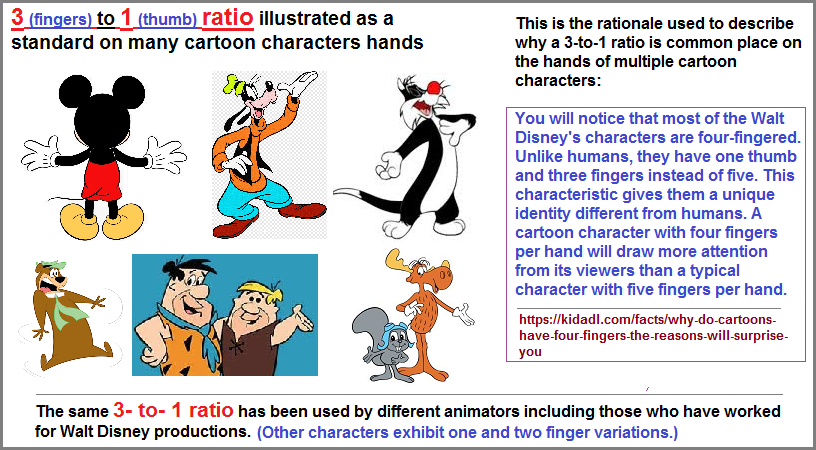

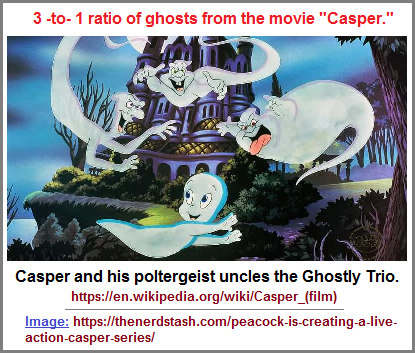
If you are only interested in a single subject or are a person who does not like to think outside the vocabulary/language or ideological box being presented by those advocating a given organizational platform for a given subject, then the alternative idea of a three-to-one ratio may not have any value for your personal orientations. Your ideas are felt to be safe and secure as well as most honest and true if you recite... (perhaps at times) verbatim, the conventions of ideas being taught in textbooks. In short, as a summary to the foregoing, the "four-patterned" concepts still reveal a unique and often distinct "three-patterned" signature. Using other-than-three patterns as a refutation of a recurrence of "threes" simply means your perspective is like someone who is trying to match simple colors without taking into account additional information, just like those who practice a standardized racial profiling. Imagine an investigator who invests their time and energy into a type of analysis synonymous with racial or gender profiling.
Some readers may not at all be familiar with any of the foregoing "4"-patterned examples, much less appreciate looking at the information and deriving a different enumerated pattern (ratio) form it. They would prefer not only images, but representations of ideas from circumstances they may have seen numerous times in the past, but disregarded them as being expressed numerical patterns. Take for example the old U.S. television show of Tarzan featuring Johnny Weissmuller. A picture of him with the other recurring cast members exhibits a 3-to-1 ratio of 3 people to 1 Chimpanzee. I include it along with three other images, all of which exhibit their own three -to- one ratio variations:
If you say and look for "four" (or instead "three") as a singular interest, you are only describing parts of a whole. The whole in this case being a three-to-one ratio. As if a three position has been stretched or a four position has either been squashed or attempting to emerge, this may be the appropriate perspective to take in one's compilation of patterns. While looking for examples of the "three" I came across examples of "four" but then took a closer look at them and distinguished a salient signature of the three pattern, all the while remaining sensitive to the possibility of a developmental transition from a lower to a higher numbered pattern as well as not to be taken aback by the possibility of a reversal, a fusion, or divergence or intermittency.
It may go without saying that millions of people have come across the foregoing pictures and overlooked the presence of a 3-to-1 ratio, and then taken this label and applied it to ideas, concepts and activities which may occur in different times and places by different people. Again, let me repeat myself by saying we are viewing a recurring cognitive pattern just as we see with patterns -of- three, one, two, four, five, six, seven, etc., but that when placed together to describe and illustrate all the patterns, some repeat more often and that overall, the collection suggests the presence of a conservation-of-number, since we do not see hundreds, thousands, millions, etc., of different patterns being repeated. Only a handful. That which is causing the Conservation... the limitation, needs to be investigated so as to determine whether the conservation is increasing, decreasing, or the overall patterning is in a transition of change... thereby providing a tell-tale sign of evolution taking place in response to incrementally deteriorating environmental conditions.
Humans laws can be viewed as a micro-cosmic representation of restrictions placed on life by Nature. Apparently, at least from a human perspective while on Earth, Nature is suffused with limitations we humans label as laws or constants. It would be difficult to live in an existence which did not have constants such as the triplet code constant found in DNA and the triplet pattern constants found in particle physics, not to mention the three constants of a period, question mark and exclamation point used in grammars throughout the world. Indeed, without a constant such as a binary code used in present day computers based on the on/off switching of an electrical circuit which dictates how computers are to function, development of and communication with a computer would be difficult to say the least.
When speaking of constants such as the repetitious usage of number patterns which can be found in the ideas of different subjects, we should also take into consideration the repetition of absence of any number, of a given number, and what pattern is present, as if one were involved with a Morse Code where dots and dashes (called dits and dahs) have spaces. Interestingly, the old symbolism of 3 and 7 comes into play:
The duration of a dah is three times the duration of a dit. Each dit or dah within an encoded character is followed by a period of signal absence, called a space, equal to the dit duration. The letters of a word are separated by a space of duration equal to three dits, and words are separated by a space equal to seven dits. Until 1949, words were separated by a space equal to five dits. (Morse Code)
In dealing with communication one needs to differentiate between vocal utterances, speech, and expressions which capture attention over a group. In some respects this idea is noted in the old biblical reference as "In the beginning was the Word, and the Word was with God, and the Word was (a) God." (John 1:1). Even if those solely interested in religion might not interpret this expression as one describing all languages, the point is that it does place an emphasis on defining language usage in three different ways. The usage of three languages to convey an idea about a singular topic has shown up in the form of a:
- Rosetta Stone languages: Demotic, Hieroglyphic, Greek
- Behistun Rock Inscription languages: Persian, Susian, Babylonish cuneiform
- Galle Trilingual Inscription languages: Chinese, Tamil, Persian

Instead of using the word "trilingual" we might use the word "triads". In one such description of triads which speaks of those with noteworthy tongues, let me provide a short reference in the form of a poem, supposedly composed by King Arthur: (Bullfinch's Mythology: The Age of Chivalry, or Legends of King Arthur)
|
“I have three heroes in battle; Mael the tall, and Llyr, with his army, And Caradoc, the pillar of Wales.” “The three principal bards of the island of Britain:- Merlin Ambrose Merlin the son of Morfyn, called also Merlin the Wild, And Taliesin, the chief of the bards.” “The three golden-tongued knights of the Court of Arthur:- Gawain, son of Gwyar, Drydvas, son of Tryphin, And Eliwood, son of Madag, ap Uther.” “The three honorable feasts of the island of Britain:– The feast of Caswallaun, after repelling Julius Caesar from this isle; The feast of Aurelius Ambrosius, after he had conquered the Saxons; And the feast of King Arthur, at Caerleon upon Usk.” “Guenever, the daughter of Laodegan the giant, Bad when little, worse when great.”... |
While the list of triads are a welcomed inclusion to my overall list of threes, (Even though I had made an earlier reference when placed on a poster: Threes Poster column 6.), the point for the present usage is to highlight the recognition of a particular model of speech described as "Golden-Tongued". It is a model which stands out, above and very often beyond the norm. We hear it in speeches, in songs, in military commands, in Business boardrooms, by way of News reporting and multiple other genres of vocal articulation, including the written models found in alphabetical and symbolic languages. So too is a particular model of research such as linguistics, though all subjects can be included in this survey. However, it is considerably different when a person like Einstein expressed his Energy to Mass equivalency formula than when someone else describes it. Clearly, when someone comes to be viewed as an authority on a subject they are listened more closely and intently to than someone who is not considered to be an authoritative representative of a given subject.
Those who are thought to be an authority are deferred to while others are merely given the benefit of a doubt if one is so inclined and circumstances permit it. However, even if one develops a particular view of thought this does not automatically mean they are sufficiently equipped to deal effectively with nay-sayers. Take for example the case of Charles Darwin and his theory of the Origin of Species which we of today generally refer to as Evolution. If not for the "bull-dogging" efforts of Thomas Huxley's support of Charles Darwin's idea(s) since Darwin was too sickly to engage in much public debate, the theory of Evolution might well have take a much longer time to come around to being accepted by many as it has. (See: Reactions to On the Origin of Species.) It was fortunate for Science at the time of Darwin's introduction that Religion was in the intense emotional state that it was. Multiple idiots in religion have been quite useful for more firmly establishing a given view directed by Scientific-styled efforts.
In my case, with respect to a "threes" research project, the idea is not a main-stream topic in Academia and previous efforts towards an interest generally found themselves in round-a-bout cul-de-sacs or dead ends such as those who focus primarily on a single subject such as religion or mythology. Such people don't take into account multiple examples from multiple sources and nor do they then come to point out flaws in current standards of thinking about a given subject. Whereas beating the heads with a big stick of those authoritative figures in a given subject's primary views can be beneficial, more subtle and persistent methods can prove to be more useful, and I don't mean the predatory and pernicious tactics used by those who wish to promote the nonsense of the Pride and other self-centered ideologies.
Whereas one speaks of the language of Physics, of Mathematics, of Chemistry... only on occasion might you come across inserting the topic of Architecture as a language... that is, outside of the Architectural community. To me, it is clear that all designs are a language much as are doodling's, scribbles, and whittling on a stick or whistling. In terms of the "three" as a type of formulaic expression used in Architecture, one might speak of the "three stone" configurations called Trilithons, with a more present day variation exhibited on some Ranch properties as a sign with two posts, though one might see two signs with one post or other variations, so as to "speak" in some model of a "threes" expression, of which a triangular geometric form is a well known example seen in Native American Tepees, Pyramids, huts, etc...

The Three Pyramids of Giza is an interesting Architectural expression. Not only does it explicitly say "three" but the geometric triangular design also describes the "three" in a more subtle way, and can be linked with as an echo of the Sun's rays seen coming through a cloud or the path of the Sun from Dawn to Dusk as seen in time-elapsed photography. Though the expression of the "three" was a cumulative effect spanning several developmental periods, just like many threes ideas which unfold over time like the development of the three Germ layers; let us note the absence of additional efforts to create a four, five, six, etc., formulation, though such thinking can take place when making a movie... even if critics come to focus on three best films after all is said and done such as in the case of Rocky saga, starring Sylvester Stallone as Rocky Balboa. However, one should come to place their count of movies in the context to which they occur, such as recognizing one hit wonders, two-hit wonders and of course Trilogies, etc... while also noting that like favorite numbers, there is a limitation.
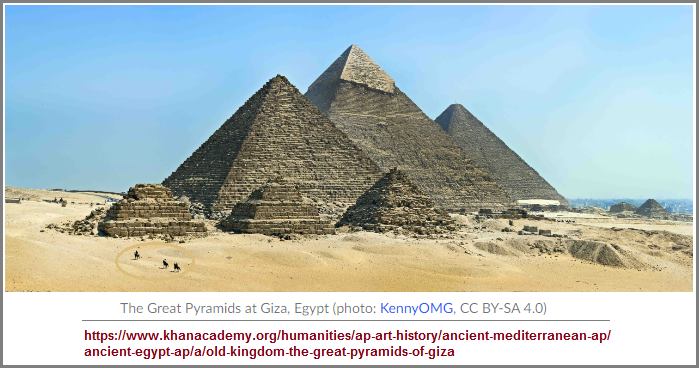
Three pyramids, three rulers
The three primary pyramids on the Giza plateau were built over the span of three generations by the rulers Khufu, Khafre, and Menkaure. Each pyramid was part of a royal mortuary complex that also included a temple at its base and a long stone causeway (some nearly 1 kilometer in length) leading east from the plateau to a valley temple on the edge of the floodplain.
A reference to the sun
The shape of the pyramid was a solar reference, perhaps intended as a solidified version of the rays of the sun. Texts talk about the sun’s rays as a ramp the pharaoh mounts to climb to the sky—the earliest pyramids, such as the Step Pyramid of Djoser at Saqqara—were actually designed as a staircase. The pyramid was also clearly connected to the sacred ben-ben stone, an icon of the primeval mound that was considered the place of initial creation. The pyramid was viewed as a place of regeneration for the deceased ruler.
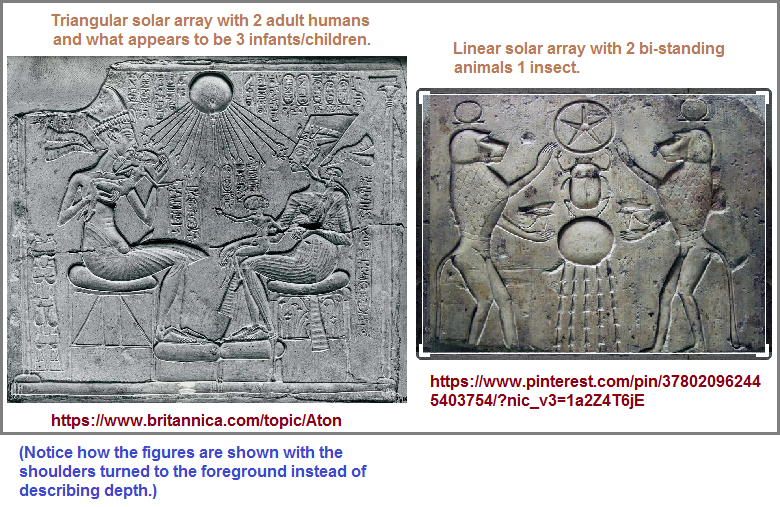
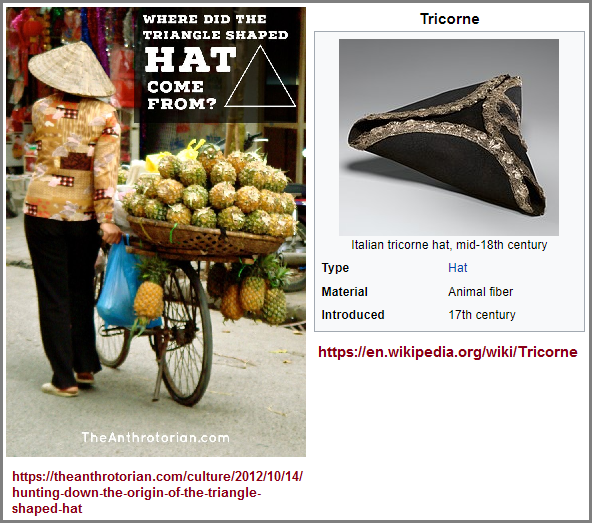
I came across the idea of the Pyramids being fashioned after the rays of the sun in an old architectural reference featuring the views of James Nasmyth as described here: Sun Rays Influenced Pyramid design?, though I was initially thinking in terms of how the Sun traveled from dawn to noon to dusk, since this idea may be more closely linked with how to explain triangular architectures among non-human life forms such as the inverted triangular burrows (pits) of Antlions and triangular-shaped Termite mounds, but that this article is found to be of interest in dealing with The Origin of the Triangle Shaped Hat by Lindsay Shapka in Culture, People, Travel, and might well be viewed as being related to the old Tricorn hat (Three-cornered hat that was popular during the 18th century). One might also include one of the several variations of references to the history of the (let us say "triangular-shaped") umbrella, not to mention the (triangular-shaped V-shaped flight formation of migrating birds and the inverted triangular-shaped object called a v-shaped engine block.) What I think is being described is a type of (let us say "rune-like") Architectural language which is, for the most part, being overlooked. The fact that crude representations of a "three" are possible, given the skill level, tools and physiology of a given species; needs to be taken into account. If it later felt such interpretations are little more than an imaginative "reach", at least we can say it is a view we had considered and then found some more profitable interpretation.
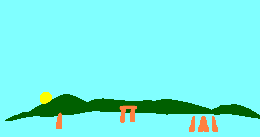
When speaking of Architectural styles, one might be thinking in terms of buildings such as the Three Greek Classical Orders and another in terms of computer software: 3 Groups of Architectural Structures by JD, Oct 1, 2008. However, the word Architecture can be used to describe the framework of any subject matter, even those which may appear at first to be idiosyncratic, weird, strange, bizarre, psychotic, ancient, modern, post-modern, futuristic, symbolic or otherwise. While one may not think in terms of (for example) the blue-print of love making, child rearing, revolution, disease, etc., one should not discount Nature as not having a blue-print which it works off of, even if the blue-print uses different types of scaffolding, depending on which structure is to be constructed according to the materials at hand, the discipline and ability of a given crew, and the state of tools at one's disposal. To such a thought whether DNA is a blueprint, a scaffold, a crude tool, a variable form of communication, or even a manufacture's tag used to instruct or caution. Indeed, is Nature an expressed Blueprint or a box out of which various products can arise out of as if a child is playing with a Classic Kaleidoscopic Tube.

The introductory paragraph is meant to say that I will repeat myself in terms of the information being supplied since I mix and match the contents as I continue writing from one day to the next. Don't be surprised to find the home page of this site changing with the addition of different information or the same information seen from different perspectives. For example, in pointing out that this site is particularly oriented towards the number "3" in terms of various patterns-of-three from different subjects, it is of need to look at different sources of number usage such as Mathematics and Numerology. However, I am not placing myself in a position of advocating either. I am merely reporting an opinion in the form of an observation. One observation is that the numbers humans routinely use are examples of limitation. It is an artefact of human cognitive activity that has not been looked at very closely as an indication of an environmentally imposed restriction for survival requirements under incrementally deteriorating conditions. (Such as for example, the Sun is burning out, the Earth's rotation is slowing, and the Moon is receding... coupled to the several other Earth-specific limitations of resources for sustaining life.) While many speak to the effects of humanity on deteriorating environmental conditions, few speak of the larger deteriorating effects involving the wider planetary system.
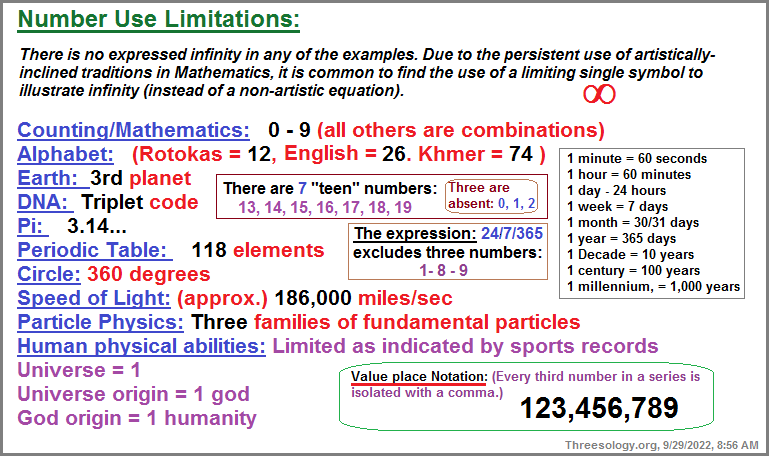
While the foregoing list on the image is but a handful, it is enough to illustrate that most numbers are small, with respect to the larger numbers available when we take the infinity of numbers into consideration. Yet, the numbers to which this site is directed are those used in multiple subjects with respect to identifying ideas created by research interests such as biology, physics, and numerous other subject areas where recurring constants can be found, such as the idea there are three theories as to the shape of the Universe, which can alternatively be called The 3 geometries of the Universe: (A flat Universe (Euclidean or zero curvature. A spherical or closed Universe (positive curvature). A hyperbolic or open Universe (negative curvature.) We might also include the three ideas as to the shape of the Earth: Flat- Round (or hemi-spherical such as a dome), and as a Triaxial ellipsoid. In addition, from different Mythological stories one might recite 3 regions such as Heaven- Earth- Hell (or Purgatory), or Asgard- Midgard- Hel (connected with 6 others in old Norse Mythology.) Yet, from most sources we see a recurring lack or absence of some number patterns.
However, though making a voluminous list of pattern-of-three examples is fun for me, it is not sufficient to answer why such a repetition exists, but is also repeatedly absent in many circumstances. (Take for example the frequent expression amongst Astronomers when they speak of a "Binary" star system and not some other enumerated star system model. Is this due to some linguistic tradition or because binary star systems are most predominant... or at least prominent from humanity's current perspective of the Universe?) While it is interesting and entertaining for some readers to have a hands-on variety of ideas which are labeled as a pattern-of-three, there may come a time when this alone does not satisfy one's curiosity. Is there a reason or is the assumed reason to be relegated to an opinion that it is mere coincidence? Is there a collective exercise of superstition taking place which focuses on a given number pattern?
Whereas years ago I came to the opinion that "We are environmentally influenced to be genetically predisposed to conceptualize many of our ideas, perform many of our activities and grow physiologically along a 1- 2- 3 maturational development sequence", further research has caused me to define this expression as a list of words which have some relative meaning, but provides only a certain level of comprehension and understanding. The fact that some of my webpages are no longer as simple as they used to be, attests to the changes in my thinking about what has been described as the "threes phenomena", though one might also cite a "ones phenomena", twos phenomena", "fours phenomena", etc... and yet also describe a limitation as to the quantity of numbers which can be similarly described as a cognitive phenomena based simply on frequency and magnitude of occurrence. The same question repeats itself to me: Out of all the infinity of numbers at our human disposal, why is it that only a very few quantity of numbers are used repetitiously? Not only must we ask if there is an unrecognized Conservation-of-Number, but a concentration- and condensation-of-number as well. (Along with condensation one must think in terms of abbreviation.)
For example, we humans have devised a number system from zero to nine, with all other numbers due to a composite. The English alphabet (for example) is 26 letters long, but all alphabets are an expression of condensation just like number systems. In other words, we don't have number and letter systems featuring hundreds or thousands of symbols, despite the claim by some who might say Chinese characters are an exception... and would be if they weren't themselves composites. Indeed, why does DNA have a triplet code and not a code in the millions? Is DNA's evolutionary growth stunted, or subjected to the same incrementally deteriorating environmental forces that physiology-based human thinking is? Why the repetitious usage of small numbers in so many subjects, despite the availability of a supposed infinity of numbers?
Whereas some readers prefer some other number than the "3" such as 2, 7, etc., and may even be able to provide a lengthy list, they do not sit back and take stock of the fact that all these numbers are low value numbers which may represent a cognitive limitation or a conservation of number. Let us take for example those who have an interest in Numerology. Out of all the numbers available to human consciousness, we find that the doubled 1- 2- 3 numbers (11, 22, 33) are considered to be the "core" numbers and that if we triple the 1- 2- 3, (111, 222, 333) and add the 4- 5 (444, 555), these are described as Angel Numbers or has some specific personal rationale or can be variously defined in terms of spirituality, physicality or meta-physicality, depending on your sensitivity to environmental cues, willingness to be open-minded and level of knowledge coupled to life-affirming (or re-affirming) experience(s).
Numerologists very often speak of "core numbers" such as the 11, 22, 33, and that in very many cases all numbers are reduced to single numbers. Because the mathematics being used by those who are interested in their observation of repeating numbers (and not all those number patterns which are absent), the Mathematical ability of Numerologists does not exceed a grade-school level of arithmetical logic (A + B = C is good enough for them because A2 + B2 = C2 is difficult and A3 + B3 = C3 is not only too complex, but is not part of their traditionalized thinking repertoire). It is not that a person's life is not more complex then the simplified Arithmetic most Numerologists engage in, it is just that most Numerologists do not have the technical thinking skills of a University level Mathematician in order to use the necessary level of Calculus (logic) which a particular person's life is on a path of, and can translate the complexity into a simplicity so that a person whose life is complex but they themselves lack the ability to think comprehensively with the necessary level of logical complexity to unravel the equation which their complex life exhibits.
Since a person's life is in the structure of a Mathematical Word Problem, it appears that many Numerologists lack the ability to decipher the life equation of a given individual and transform this into a formulaic expression which can be worked out and then translated into the necessary language a particular person is enabled to best grasp and make use of. Too many Numerologists are failing their clients because they misinterpret the complexity of a person's life because they are stuck on using the old, out-dated axioms presented by traditional Numerology and its indices. Numerologists (and other professionals) are like many a psychologist who manipulates a client along a path of interpretation of derived simplicity, only because they are most comfortable in working with a specific box of (stick, bone and rock) thinking tools, though they are particularly adept at using such crude tools like any partitioner of a respective craft; but are incapable of using updated and refined tools that are better suited for the particularities of a given individual born in an age and under conditions uniquely removed from the era in which the old tools of thinking were a good fit; but whose continued usage creates pieces of living work which are fine for museums behind glass cases, ancient gardens and old library walkways, but not the land of the living with its many dynamics.
(Second half of this page moved to page 22)
Date of (series) Origination: Saturday, 14th March 2020... 6:11 AM
Date of Initial Posting (this page): 1st March 2022... 6:04 AM
Updated Posting:Friday, 7th October 2022... 5:23 AM, MST; Albuquerque, NM.
